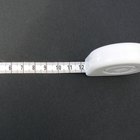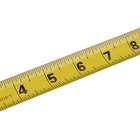
Shopping for the preteen or young teen girl can be a challenge. The children's department can be filled with clothes deemed too young by the adolescent girl. Clothes found in such chains as Forever 21 and Wet Seal or in department store junior departments tend to be trendier and can be less expensive than their children's department counterparts. While standard children's sizes run in even numbers, from 2 through 14 or 16, junior department sizes run in odd numbers from 0 through 13 or commonly in XS (extra small) through L (large.) Junior department selections are suitable for a slightly curvier figure.
Standard U.S. Sizing

Measure chest, waist and hips to determine correct size in either children's or junior clothing. Chest measurement is found by using a measuring tape around highest part of chest, passing tape around underarms. Arms should be relaxed at size. Waist measurement should be taken at waist parallel to floor. Hip measurements should be at widest point of hip, also parallel to floor.

Convert children's size chart below to junior sizes. Children's sizes 12 through 14 are basically equivalent to junior sizes. Occasionally, children's sizes are available in 16, which also can be converted to a junior size. Junior sizes fit better on a curvier figure than do children's sizes.
Chest, 30.5 inches; waist, 25.5 inches; hips, 32.5 inches: children's size 12; junior size 1 or XS
Chest, 32 inches; waist, 26.5 inches; hips, 34.5: children's size 14; junior size 3 or S.
Chest, 33.5 inches; waist, 27.5 inches; hips, 36.5 inches: Children's size 16; junior size 5 or M.

Visit several junior apparel stores to determine actual sizing. Pants and jeans might be more difficult to fit because junior sizes are longer than children's sizes. Junior sizes are fit based on a height of 5 feet, 4 inches or 5 feet, 5 inches.
Related Articles

Difference in Misses, Juniors, and ...

How to Convert Girls' Clothing Sizes to ...

How to Size Boys' Clothes

How to Measure for Children's Clothes

How to Shrink Pajamas

How to Determine a Cross Dresser's ...

Ideal Weight Vs. Dress Size

Korean vs. American Clothing Sizes for ...

How to Measure Your Pant Size in Juniors

What Is a Plunge Bra?

How to Take Measurements for a Raincoat

What Does Big Kids Mean in Shoe Sizing?

How to Buy Play-Doh in Bulk

Types of Hotel Rooms

How to Find Fashionable Shoes for Women ...

The Calories in Garbanzo Beans

How to Size Foamposite

What Is Comparable to a Size 10 Dress ...
Things to Do with Kids in Los Angeles

How to Convert Kids' Clothing Size to ...
References
Writer Bio
Beth Cone is a Los Angeles-based writer and was the style and health, beauty, and fitness columnist for "On The Boulevard Magazine" in the San Fernando Valley-based magazine from 1990 through 1992. She is a publicist and artists representative with clients in Northern and Southern California. A graduate from Vanderbilt University, Cone has a degree in Spanish and fine arts.
Photo Credits
Jessica Isaac/Demand Media